By Beth Hagenauer
Dryden Public Affairs
I settled into my assigned seat for the 10-hour journey. The red-eye flight would cross 11 states, eventually reaching an altitude of 44,000 feet and traveling 4,700 miles. The ticket price was very good – it came as part of my job as a public affairs media escort for a prestigious documentary crew.
As the aircraft lifted off at dusk from the Air Force Plant 42 runway in Palmdale, Calif., I realized this would be no ordinary 747 flight; I was aboard the SOFIA, or the Stratospheric Observatory for Infrared Astronomy, a flying astronomy observatory.
SOFIA is the airborne platform for a joint program between NASA and the German Aerospace Center DLR. The program is based at NASA’s Dryden Aircraft Operations Facility in Palmdale. To modify the 747 for its new role, a 16-foot-high hole has been cut in the aircraft’s port side and a one-of-a-kind infrared telescope installed in the opening. Most of the former airliner’s trappings – seats, food-preparation galley and movie screens – have been removed and replaced with workstations equipped with computers and sturdy passenger seats with five-point seat-belt harnesses.  Image right: Terry Herter, principal investigator with the FORCAST instrument, takes a minute during a SOFIA flight to explain a concept to a visiting television crew.
Image right: Terry Herter, principal investigator with the FORCAST instrument, takes a minute during a SOFIA flight to explain a concept to a visiting television crew.
The television film crew was aboard to record the science mission; their viewers who have a working knowledge of astronomy are familiar with ground-based telescopes and satellites, but an aircraft carrying a telescope brings a different dimension to studying the solar system. The usual flight crew was on tap for the mission, but so was a gaggle of German and American scientists and telescope operators who had planned a flight route that would take us to observation points for targets with names like Alpha Boo and Frosty Leo – the latter, I learned, a dying star. The 17-ton German-built telescope sports a Cornell University instrument called FORCAST, which is an acronym for Faint Object Infrared Camera for the SOFIA Telescope.
As soon as the “Fasten Seat Belt” sign was turned off, the science crew took their stations at consoles outfitted with computer screens to begin their night’s work. About an hour into the flight, the exterior door covering the telescope cavity was opened. White dots of varying sizes surrounded by colored boxes and text that seemed to be astronomers’ code began to appear on the computer screens. The aircraft is very noisy, so all communication was via headset. One of the mission director’s tasks is to monitor scientists’ conversations and transmit information to and from the pilots if necessary – say, for changes to the flight plan that might mean getting a better look at a target.
About three hours into the flight, I went upstairs to the cockpit. More than 500 tiny lights illuminated a variety of circuit breakers and gages; the SOFIA cockpit is original technology and has not yet been upgraded with a “glass” cockpit, the current standard in modern aircraft. Looking out of the windows, I saw a sea of clouds lit by the full moon. It was easy to see stars with the naked eye – or visible light, as the astronomers refer to it – in the dark sky.
Unlike the environment in the main cabin, the cockpit was quiet except for occasional radio transmission between the NASA 747 and Federal Aviation Administration air traffic controllers in Seattle.
The most auspicious passenger was a small stuffed koala mascot that had flown more than four million miles on SOFIA’s predecessor, NASA’s fabled Kuiper Airborne Observatory. Earlier this year, the bear had been passed, along with the astronomical-research torch, from one generation of NASA scientists to the next.
 As the flight progressed the scientists continued their work, the adrenalin rush that comes from collecting real-time science data keeping them awake. (It had to have been that, because there was no hot coffee anywhere on board.) A flight on SOFIA is literally the only opportunity astronomers get to conduct their work in a shirtsleeve environment.
As the flight progressed the scientists continued their work, the adrenalin rush that comes from collecting real-time science data keeping them awake. (It had to have been that, because there was no hot coffee anywhere on board.) A flight on SOFIA is literally the only opportunity astronomers get to conduct their work in a shirtsleeve environment.
And my impression? Not being an astronomer by training, I still found myself in awe of the telescope. I never tired of watching its slow and precise movements, knowing that this activity replicates a tilting of the telescope mirror that was “peering” at the stars from within its specially designed cavity.
I brought my own dinner, since not even the dreaded “airline food” was available. I put my coat on when the aircraft reached 44,000 feet. Above all, I was tired when the aircraft landed at dawn back in Palmdale. As I watched SOFIA being towed back into the hangar and sent a very happy film crew on their way, I was reminded of a phrase that I’ve heard NASA colleagues say many times: “…and they pay me to do this?!”

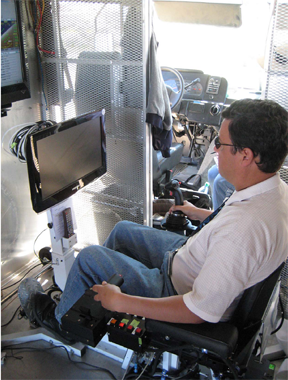
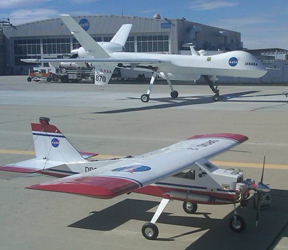
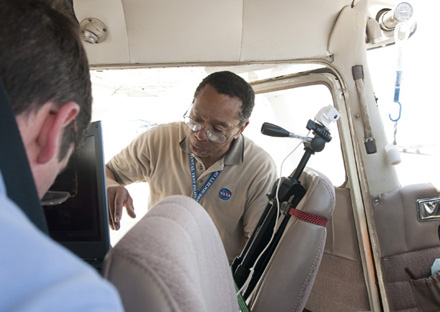 We set up a laptop and webcam in a Cessna 172 for a flight over the Antelope Valley. We installed an Internet “hotspot” in the plane and established an Internet connection with the class before takeoff by using free Skype video-conferencing software. Before the flight, via a NASA Digital Learning Network link-up, Dryden operations engineer Callie Holland explained the purpose and techniques used in a real-world control room so the students would understand what they were about to do. Then she gave them our pilot test cards, which had blank spaces in which students could copy the climb, cruise and turn performance data in real time during the flight.
We set up a laptop and webcam in a Cessna 172 for a flight over the Antelope Valley. We installed an Internet “hotspot” in the plane and established an Internet connection with the class before takeoff by using free Skype video-conferencing software. Before the flight, via a NASA Digital Learning Network link-up, Dryden operations engineer Callie Holland explained the purpose and techniques used in a real-world control room so the students would understand what they were about to do. Then she gave them our pilot test cards, which had blank spaces in which students could copy the climb, cruise and turn performance data in real time during the flight.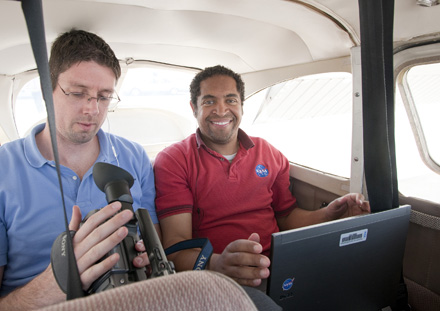 Image left: Dryden Distance Learning Network coordinator David Alexander, right, and Shaun Smith from the Dryden education office provide support (from the back seat) for the digital link-up that made the project possible.
Image left: Dryden Distance Learning Network coordinator David Alexander, right, and Shaun Smith from the Dryden education office provide support (from the back seat) for the digital link-up that made the project possible.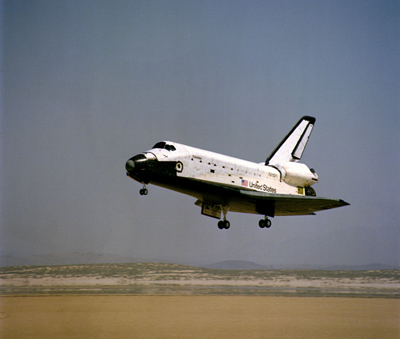
 By Al Bowers
By Al Bowers
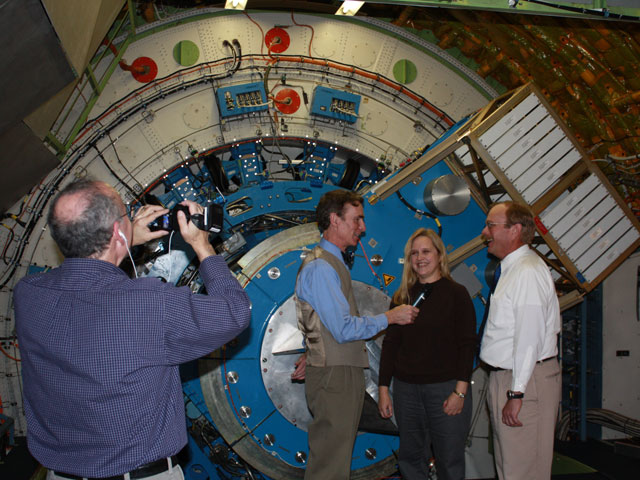
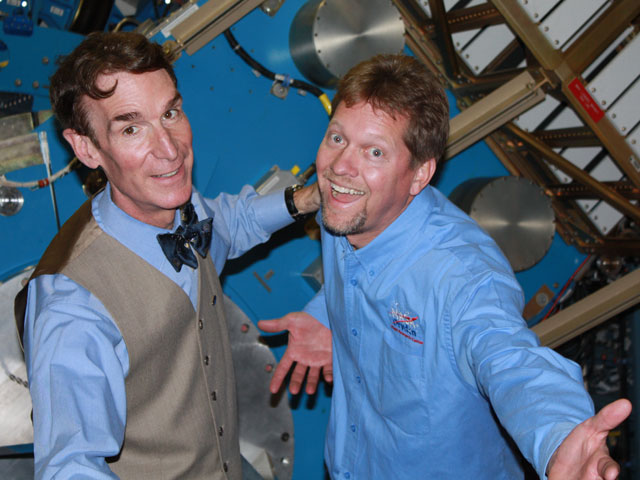
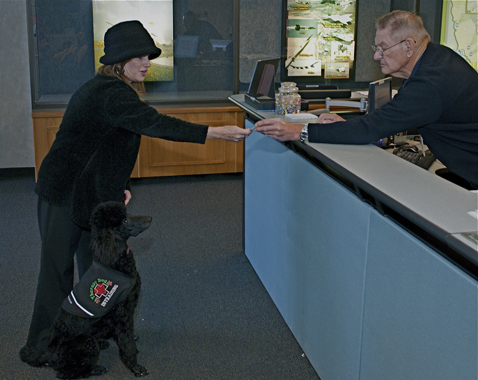 This is the end of my fourth week at work. There are so many new things I get to see and do. The people aren’t so anxious, and they don’t lean down so fast when they see me. She seems calmer, too. The people know my name. I like to hear it down the hallways and when they come into Her office. When we walk into the big buildings, I hear my name come from out of doorways, or from far down the hall. Sometimes we stop and talk to the people. They touch me and I like that a lot.
This is the end of my fourth week at work. There are so many new things I get to see and do. The people aren’t so anxious, and they don’t lean down so fast when they see me. She seems calmer, too. The people know my name. I like to hear it down the hallways and when they come into Her office. When we walk into the big buildings, I hear my name come from out of doorways, or from far down the hall. Sometimes we stop and talk to the people. They touch me and I like that a lot. 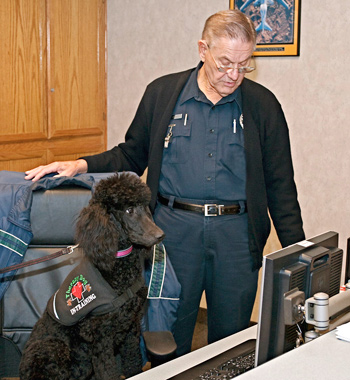 Ella’s first weeks have been exciting. She has blossomed from being reserved and rather overwhelmed to being overtly happy and welcoming to most of the people she meets. In fact, it is now time to start the next phase of training. She is very good on the leash, but now she is starting to want to walk ahead and take the lead. I understand that not everyone wants to touch her, and so she has to learn to wait to be told by me that she can greet someone. I am struggling with her initiative. Like working with a shy or uncertain child just coming out of their shell, there is a point at which some discipline must be applied. Timing will be very important. I think I’ll wait for a few more weeks; I don’t want to start too soon lest she become discouraged.
Ella’s first weeks have been exciting. She has blossomed from being reserved and rather overwhelmed to being overtly happy and welcoming to most of the people she meets. In fact, it is now time to start the next phase of training. She is very good on the leash, but now she is starting to want to walk ahead and take the lead. I understand that not everyone wants to touch her, and so she has to learn to wait to be told by me that she can greet someone. I am struggling with her initiative. Like working with a shy or uncertain child just coming out of their shell, there is a point at which some discipline must be applied. Timing will be very important. I think I’ll wait for a few more weeks; I don’t want to start too soon lest she become discouraged.